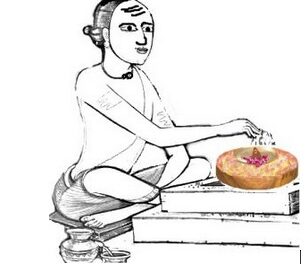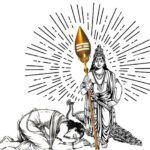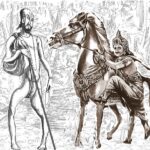
KULA DEVATHA OR TUTELARY/FAMILY DEITIES:
ORIGIN AND CONCEPT
-Santhipriya-
-8-
129.The next most important question that arises is whether the Kula Devatha or Tutelary/Family deities were the creation of Lord Brahma? The answer is a clear ‘NO’ as the role of Lord Brahma is only limited to work out their place and period of manifestation of various divines. Then how do they get identified as Kula Devatha or Tutelary/Family deities? In general, the Folk deities of all varieties manifest only in the lands allotted to them by Lord Brahma at the time pre determined to them and then reveal their presence through dreams of some of the villagers or spoke through those who were afflicted with trance in village festivals to convey that such and such divine are in such and such place and if they were worshiped or prayed in those places, all their problems would be redressed. As stated in earlier parts, each Kula Devatha or Tutelary/Family has been allotted specific area and land for manifestation, the Village and or guardian deities to assist them, and specific group of people who would be under their control. Thus they can not go and manifest in any other land of their choice and all acts of divines were pre determined by Lord Brahma.
130. Simultaneously certain deliberate and artificial problems would be created to some of the folks who had no choice but to seek divine intervention to get relief. Unable to get relief elsewhere, as they go to those sthal (worship spot) and offer prayers as commanded to them, their problems begin to vanish. At the same time the genuine problems of others and the nature’s fury were also contained by the hidden ganas through the intervention of their master first line of deities, the secret of which were not known to humans.
131. Gradually the invisible divines began to appear in the dreams of some of the folks to tell them to start worshiping them so that they would be protected from unknown spirits and nature’s fury. Thus, the sinned and cursed Deva ganas and Village deities get recognition over period of time and become Kula Devatha or Tutelary/Family deities in those places where they performed magical acts.
132. In short, to generate tutelary deities over a period of time, Lord Brahma enacts certain plays so that the humans with good deeds first turn into deva ganas. The deva ganas enter into the body of some human or animal and become guardian angel. The guardian angels by the mysterious acts of divine become village deities. The Folk deities by certain divine acts ultimately become tutelary deities to the folks of that land. Everything happened to the fine-tuned plan of Lord Brahma, whose ultimate aim was to establish the Kula Devatha or Tutelary/Family deities worship on earth.
133. The nature of sins acquired by the Deva ganas in Parabrahman Loga is different from the humans who get afflicted with sins on earth. Both are different. Those Deva ganas and divines which deliberately evaded their duties in Parabrahman Loga were afflicted with sin/curses, which was considered to be more heinous crime than the sin acquired by the one on earth.
134. This is how the sinned ganas who came to earth to get relieved of their curses struggled for long period of time till some first line of divine intervened to pardon and relieve them of their curses or sins to get them some status-guardian deities, village deities, Kula Devatha or Tutelary/Family deity there. But none of these divine dramas were known to the folks of the land and only spiritual masters and divine incarnates understand them.
135. The texts in Purana and history of temples contain many stories that state that several divines manifested in human form and penanced to get the curses reversed in specific spots indicated to them on earth. During the atonement period they were allowed to exercise only very limited divine powers in discreet manner to benefit mankind but would not be able to exercise full powers because they had to suffer as human to atone their sins.
136. The norms of Brahma were very clear in this sphere. Had the divines been permitted to carry out their entire divine energies when they were in human form, they could misuse them to soften the nature of punishments during their stay on earth. Similar to the humans who struggle to get freed of their past karma through prayers, services etc, in the same manner the cursed divines who come to the earth for penance should also get freed of their karmas (sins/curses) only by struggle and therefore to prevent misuse of divine powers they were prohibited from carrying the entire divine powers during the period of penance.
137. The minor curses received even by Prime divines during their stay in Parabrahman Loga were to be redeemed by penance in earth. Therefore, those Prime divines which came to earth to atone the sins in disguise as human, carried lesser divine powers and displayed them only rarely during their stay on earth. This is one of the reasons why the manifestations had not been accorded the status of divine or Kula Devatha or Tutelary/Family deity immediately upon their manifestation and attained the status several thousand years later. The classic examples of some of those divines were Lord Muruga, Lord Rama, Lord Krishna, Lord Parasurama, Goddess Parvathi, Goddess Lakshmi, Goddess Valli, Goddess Sita or even Goddess Sarasvati. While Goddess Valli has been accorded the independent status of Kula Devatha or Tutelary/Family deity in many different names, it is surprising to note that Goddess Devayanai, Goddess Saraswathi and Goddess Sita have not attained that status and some of them had always been worshiped along with their spouses only.
138. Besides those four lines of divines, Lord Brahma also converted few more souls into bad spirits, ghosts, and destructive divines in the form of humans as sinned ganas, which were in fifth line. The mysterious and hidden norm of Brahma was that the souls which absorbed the negative energies beyond maximum allowed, the limit of which of course was also not deliberately made known to them, would instantly become invisible floating ghosts and spirits. The most important reason why they were created by Lord Brahma was to display to the folks, the difference between evils and other divines.
139. In earlier parts of my article, I had mentioned that before sending souls into space on earth, Lord Brahma divided the spaces into several divisions, each imbibed with several qualities, the qualities which were not uniform with one another, and the souls which reached there absorbed those qualities which were in the form of energy rays. The qualities were negative and positive in nature and in the form of energy rays. Here too Lord Brahma deliberately left one issue open. Similar to the freedom given to the souls to choose their area of destination on spaces, Lord Brahma’s norms mysteriously did not specify the quantum of energy rays to be absorbed by those who landed in that space but was left to the discretion of the souls.
140. Reading the texts of epics, Puranas and other scriptures, it is evident that the concept of divine worship including the Kula Devatha or Tutelary/Family deity did exist during the period of Vedas. For example there are references to Brahmins in ancient texts such as Ramayana, Mahabharata, Bhagavatham, Rig Veda and Bhavishya Puranas. One sect in the Brahmins who were predominant in the period of Veda were Saraswath Brahmins who resided in the banks of River Saraswathi. Those Saraswath Brahmins are known to belong to Gothra of the seven Rishis first created by Lord Brahma. Traditionally it is said that each Kula or descendants of a family belong to a distinctive Gothra, each Gothra representing one of the seven Saptha Rishis. The Saraswath Brahmins who perhaps have ten Gothra in the name of ten Maharishis have the long history and conventional practice of worshiping eight specific Kula Devadas, which indicates that the concept of Kula Devatha worship prevailed even in Vedic period. This will clarify how the Kula Devatha or Tutelary/Family deity were adapted by families. There are several historical stories on Saraswath Brahmins to prove this point.
141. The practice of Kula Devatha or Tutelary/Family deity worship surfaced beginning from Vedic period when there were no castes or religion and everyone alike worshipped the same form of divines. In the greatest epics like Ramayana and Mahabharata too there were no references on castes and religion like Hindus, non-Hindus, but only human divide classifying the society into four Varnas or classes – based on their capabilities to perform certain functions were mentioned.
142. Since the concept and worship of Tutelary/Family deities have been discussed in the introductory paras, traditional folks still believe in the worship of multiple divine forms for spiritual enlightenment to safeguard families and for progress in life. However they preferred worship of Kula Devatha or Tutelary/Family deity who may either be a male or female divine as worshipped by their ancestors in their families.
143. The concept of Kula Devatha or Tutelary/Family deity worship prevail on high note only in India, especially in the southern part of India. Hence this article is mostly confined to the worship pattern in India and only for comparison the divine worship pattern in different other names existing in other countries in the Universe is cited in some places.
144. Were entire humans born on land worshipped some form of Kula Devatha or Tutelary/Family deity? Who guided, guarded and granted the prayers of humans who had not adapted any tutelary or family deity?
145. Not entire human race had Kula Devatha or Tutelary/Family deities. Only those belonging to families who had Kula Devatha or Tutelary/Family deity for generations continued to worship them while the rest worshipped other divines of their choice in the same area or elsewhere as Ishta Devathas (Divine of liking), got guided and guarded by their grace as long as they worshipped them sincerely.
146. In the the case of Kula Devatha or Tutelary/Family deities, even if one in the family ignored the worship of the Kula Devatha or Tutelary/Family deity, the other family members continued to receive the protection and guidance of the tutelary deities. The one who ignored the worship remained cursed and left to face several hurdles in his life.
147. What about the powers of the Kula Devatha or Tutelary/Family ? The Brahman rule is such that the Kula Devatha or Tutelary/Family deity would enjoy enormous powers like first and second lines of divines in all respects as they were also manifestations from the same Prime divines to carry on their duties and to function independently without interference from other divines.
148. Can other divines manifest in the areas allotted to Kula Devatha or Tutelary/Family deities? Provisions have been kept for the manifestation of some other divines in the same areas. Brahman rule stipulate that the Kula Devatha or Tutelary/Family deity or any other divines manifested in an area remain non interfering in each other’s domain and without violating the basic norms of Brahma rule.
149. Though specific territory may have been allotted for divines in the initial stages to guard and guide the folks, geographical changes which include erosion, migration of people, desertification and globalization could alter the characteristics of the land. Human migration involves the movement of people from one place to another either in family units or in large groups for whatever reasons. In such scenario when people in mass scale migrate to another land, who would guide and guard those folks who had worshipped Kula Devatha or Tutelary/Family deity in the land from where they migrated?
150. In order to safeguard their interest and guide them, the Kula Devatha or Tutelary/Family deity of migrant forces too, enter into the territory and exercise control over those who were already under their custody in the earlier land from where they migrated. At the same time Kula Devatha or Tutelary/Family deity thus entering into others territory to exercise their authority would not in any manner interfere into the working of the other Kula Devatha or Tutelary/Family deity already functioning there for some other group of folks.
151. Similarly the Kula Devatha or Tutelary/Family deity under whose command the territory lay would also not obstruct to the entry of the Kula Devatha or Tutelary/Family deity to guide and guard those migrant folks who were under their control elsewhere. Both sets of Kula Devatha or Tutelary/Family deities would confine to their act of safeguarding the folks assigned to them thus strictly adhering to the rule of Lord Brahman.
152. How does this system work? Let’s assume that in a village called Nalamangala, 200 families were under the command of five Kula Devatha or Tutelary/Family deities as assigned by Lord Brahma, each Tutelary/Family deity or Kula Devatha, (Say A,B,C to D deities) taking care of 25 to 30 families each. The remaining families (those without Kula Devatha or Tutelary/Family deities), say around 50 or more were left to worship some other divines of their choice as Ishta Devatha either in the same space (the Village or towns are referred in this article as space) or elsewhere beyond the said territory.
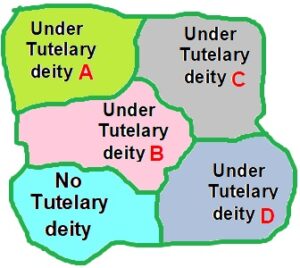
153. Let us say for some reason or the other, some members of a family (Let us call them ‘A’ group) perform Yagna or other Pooja praying their Kula Devatha or Tutelary/Family deity or Ishta Devatha or some Prime divines to harm certain family (Let us call them ‘B’ group) inimical to them. Howsoever powerful the Kula Devatha or Tutelary/Family deity of ‘A’ may be, or the Prime divines who were prayed, they cannot unilaterally accede to the request of ‘A’ group to harm ‘B’ group who sincerely and regularly maintained worship of their Kula Devatha or Tutelary/Family deity and had also not actually committed any crime against members of group ‘A’. Therefore before granting the wishes of ‘A’ group , the divines who were prayed would have to first consult the tutelary deities of the ‘B’ group and discuss the issue and if need be get the wish fulfilled only with their consent, provided the prayers of ‘A’ group was genuine. Even on remote possibilities, the prayed divines cannot act unilaterally to cause harm to ‘B’ group by granting the wishes without informing or consulting the tutelary deities of ‘B’ group since there exist tough restriction in the form of norms of Lord Brahma.
154. As per Brahman norm if arbitrary decisions are taken by the divines to cause harm to the families under control of another Kula Devatha or Tutelary/Family deity /or deities, without mutual consultation, such divine acts would be construed as violation of Brahma norm and infringement into the divine rights of the other deities and the awarded boon would fail to cause ill effect even though the group of ‘A’ may outwardly feel glee that their prayers have been answered unaware of the internal divine failure.
155. Also, since the devotees of the Kula Devatha or Tutelary/Family deities are ring protected with the divine rays of the Kula Devatha or Tutelary/Family deities, the incoming harm causing energies of deity ‘A’ would get blocked unless they had the prior permission from deities of “B” to mete out the punishment. The divines which defy the rule and attempt to arbitrarily rule over the Kula Devatha or Tutelary/Family deity would get attracted by sins or curse from Lord Brahma and lose their divine powers temporarily. This is how in one manner or the other even the Prime divines too get curses unknowingly. Thus, the regular and continuous worship of Kula Devatha or Tutelary/Family deity give protective cover to those families under the guard of Kula Devatha or Tutelary/Family deity.
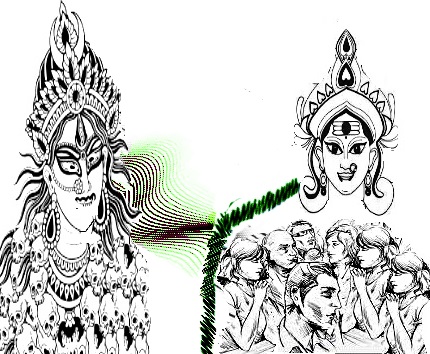
156. There is however a small rider in this norm too. Since the divines are also meant for establishing law of justice and love amongst mankind, if the Kula Devatha or Tutelary/Family deity finds that the group ‘B’ had been wanton sinners against group ‘A’, then the Kula Devatha or Tutelary/Family deity would temporarily withdraw their protective cover from group ‘B’ to ensure that the canon of divine justice by way of boons given by Prime divines to group ‘A’ are not blocked in any manner.
157. In the above example, how does the award of wishes punish the defaulters? Once the prayers of group ‘A’ is answered, then the resultant boon gets converted into the shape of negative energy rays and reach the person or group concerned say group ‘B,’ and intrude into them activating harmful effects on their prosperity and happiness and health when their Kula Devatha or Tutelary/Family will close their eyes to carry out the punishment. This results in endless struggle and mental agony to the ‘B’ group destabilizing them in many ways.
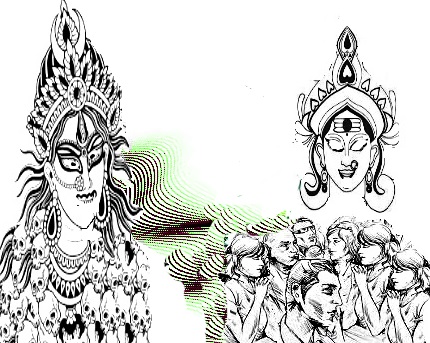
158. At the same time the Kula Devatha or Tutelary/Family deity are also empowered to condone the punishment at later stage when the punished group ‘B’ continuously and sincerely prayed (without knowing the reasons for their sudden suffering) to their Kula Devatha or Tutelary/Family deity seeking relief from their problems and upon satisfied with their sincere prayers, the Kula Devatha or Tutelary/Family deity could revoke the punishment given by the other divine, again only after due consultation with the divine which meted out the punishment. There are many such hidden norms and riders that curb the unilateral decisions of divines against fellow divine acts which remains beyond the scope of humans to clarify or understand.
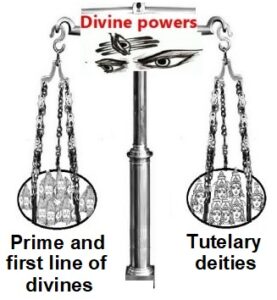
159. In order to maintain the dignity and honour of the divines, Lord Brahma has incorporated several such norms for the functioning of divines as he was aware that the entire fleet of Kula Devatha or Tutelary/Family deity are the same energy rays of Parabrahman and therefore insulting or degrading the powers of the Kula Devatha or Tutelary/Family deity or infringing into their domain without due permission would be tantamount to insulting their manifestation and the purpose for which they had come.
160. All the above will illustrate that similar to the humans, the divines are also covered by certain norms in exercising their power and authority. All these have been done to show to the universe that the rule of law and justice is not limited to the mankind alone, but also applicable to the divines of land- Devaloga.
Part- 9 Continued…….
—————————————————-
References:- Some of the information found in the following sites, folk lores, discussions with temple Pundits and elders of yester year generations helped me in compiling the above article.
(1)https://en.wikipedia.org/wiki/Gr%C4%81madevat%C4%81
(2)Many stories from Shri P.R. Ramachander’s Blog: http://villagegods.blogspot.com/
(3)https://en.wikipedia.org/wiki/Village_deities_of_Sri_Lankan_Tamils
(4)https://en.wikipedia.org/wiki/Tutelary_deity
(5)https://navrangindia.blogspot.com/2018/04/twenty-important-facts-about-worshiping.html
(6)https://www.wisdomlib.org/definition/kuladevata
(7)https://hinduism.stackexchange.com/questions/12329/what-is-the-origin-of-kula-devata-or-family-deity
(8)https://hellenicfaith.com/tutelary-deities/
(9)https://www.tamilbrahmins.com/threads/brahmins-kula-devatha.3111/
(10)http://www.sanskrutionline.com/home/history.html
(11)http://vaisshnav.blogspot.com/2015/12/kula-deivam-do-we-need-to-pray-to-kula.html
(12)https://everything.explained.today/Tutelary_deity/
(13)https://www.hindu-blog.com/2015/08/goddess-kubjika.html
(14)https://www.britannica.com/topic/Archon-Gnosticism
(15)https://www.rkaroma.com
(16)https://www.encyclopedia.com/environment/encyclopedias-almanacs-transcripts-and-maps/goddess-worship-goddess-worship-ancient-near-east
(17)https://www.missionkuldevi.in/en/2017/04/audichya-brahmin-samaj-gotra-kuldevi-list-history/
(18)https://www.facebook.com/groups/163154720690884/posts/906180419721640/
(19)http://www.sanskrutionline.com/home/history.html
(20)http://gsbkonkanis.weebly.com/kula-devathas.html
(21)https://srimad.org/?p=507
(22)https://krishnatoday.com/kuladevatha-and-krishna-devotees/
(23)https://ramtarak.com/5-amazing-facts-to-pray-kuladevata/
(24)https://chowdeshwaritemple.com/
(25)https://srivadapathirakali.org/sriambal.php
(26)https://hindi.webdunia.com/sanatan-dharma-niti-niyam/kuldevi-puja-121051100041_1.html
(27)http://www.pernekshetra.com/historyincarnation
(28)https://www.historydiscussion.net/history-of-india/early-vedic-period/the-early-vedic-period/6244
(29)https://shrigurumaharishi.org/2019/10/03/why-should-we-worship-our-kuladeivam-family-deity/
(30) Many temple histories contain curses redeemed by divines
(31)http://www.tripura.org.in/fourteengods.htm
——————————–
Acknowledgement: I acknowledge with grateful thanks, Dr. V. Sankarkumar, consultant medical officer in USA, who edited my article with valuable inputs before publishing it. He has been writing articles of spiritual nature in both Tamil and in English and has contributed much in one of the Shirdi Saibaba blogger (https://shirdisaibabatamilstories.blogspot.com/-in which I was one of the two coordinators) by translating the English articles into Tamil. … N.R. Jayaraman (nrj1945@gmail.com).


